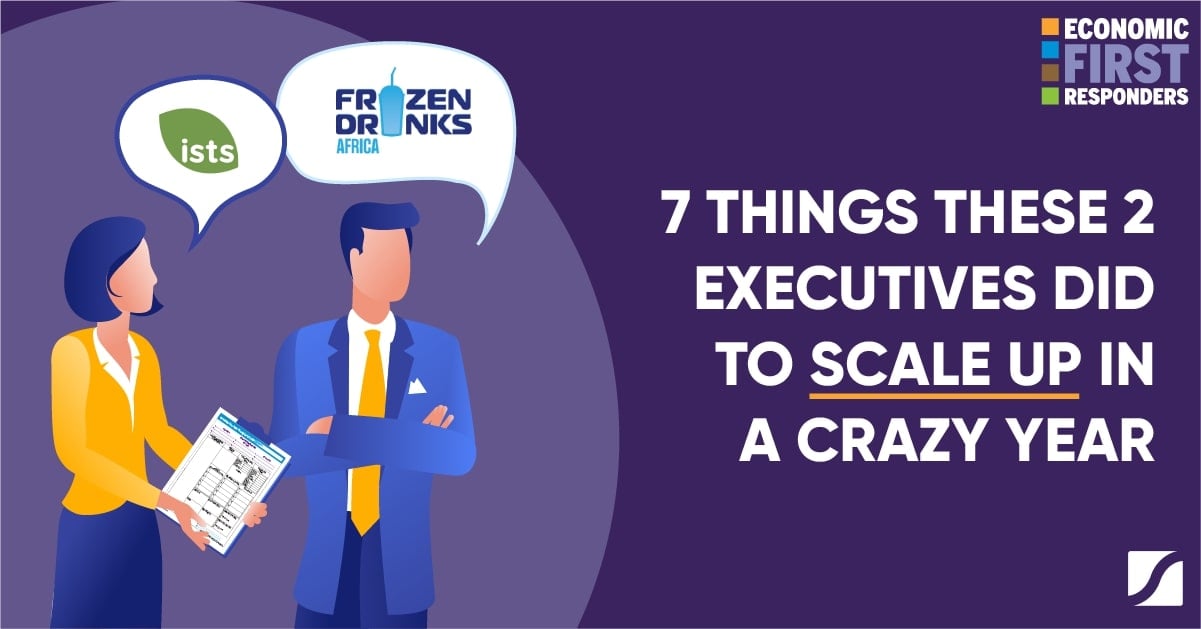4 Keys Your Business Needs to Survive an Economic Downturn
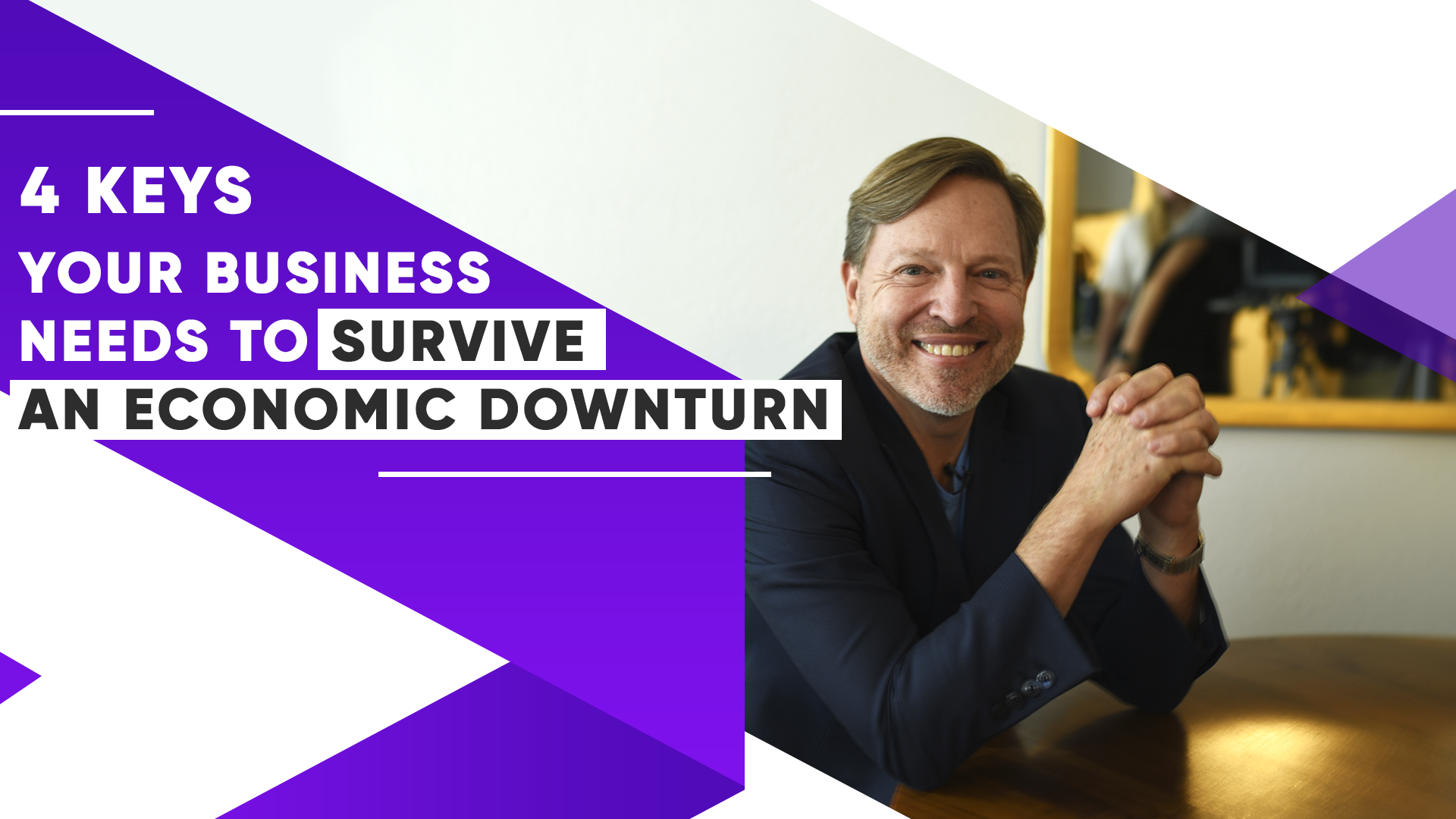
The world economy has been hit hard and as leaders we’re all wondering the same thing:
What can a business do to survive an economic downturn?
The only tool that’s going to get us out of this is right between our ears. The quality and speed of how we implement our ideas will determine how we pull ourselves through these tough times.
As the business leaders at mid-market companies, we have a big responsibility on our shoulders.
After the Great Recession, 92% of job growth came from the mid-market category. I predict that it will be the same scenario this time round and it’s going to largely be the mid-market organizations pulling us out of this mess.
So you, the unsung heroes of our economy, play an important role. But you’re also not alone. If we stick together, we’ll get through this together.
I recently met with a group of leaders online to share the four keys you need to help your company survive an economic crisis.
If you missed the live event, not a problem. Read on to learn the key takeaways to help you prepare your business for a recession, and come out on the other side thriving.
The Most Important Takeaways: 4 Keys to Manage Chaos
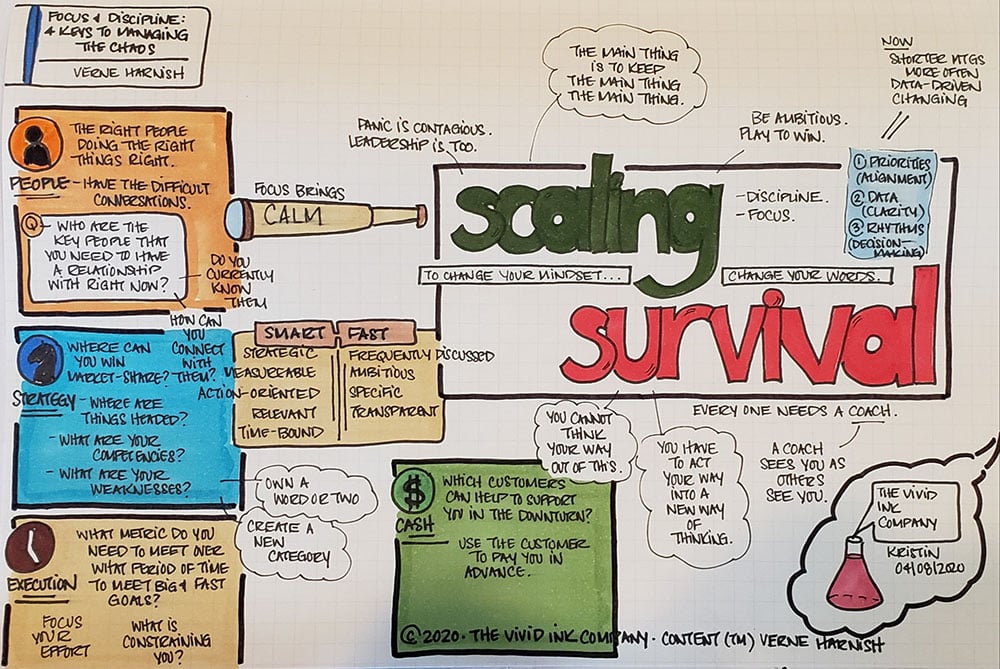
Visual summary by Kristin McLane of The Vivid Ink Company.
Follow her on Facebook and LinkedIn for more learning snapshots.
Moving from SMART Goals to FAST Goals
Adaptability is key. You need to move quickly — from faster decision-making to faster execution. This is why I recommend a move from SMART Goals to FAST Goals.
I’m sure you’re already familiar with SMART goals: Specific, Measurable, Attainable, Relevant, Time-Based. With the current situation, it’s better to go FAST: Frequently Discussed, Ambitious, Specific, and Transparent.
Frequently Discussed
I want to emphasize that you cannot think your way out of this mess. You can only talk your way out. The only way to know what step you should be taking next is by having the right data. This is why you need to be talking to your team, customers, suppliers, potential partners, the market, and so on — frequently.
Having the right data in a timely manner will allow you to either pivot and build, or rebuild quickly. To achieve this under current conditions, you need to pick up the pace of communication rhythms. Meetings need to be shorter and more frequent.
For example, a lot of our clients are now having daily huddles twice a day – instead of the standard once a day. In addition to receiving crucial data and continuously aligning the team, this also helps everyone stay focused during unpredictable times. Focus drives calm, which is absolutely crucial right now.
Ambitious
Most of us have already planned our Big, Hairy, Audacious Goal. But this is not the focus right now, right now you should be thinking about how to re-strategize. We need to assume that not one additional traditional dollar from our existing business model is going to come in over the next six months. We need to plan for the worst.
But we also need to hope for the best. Now is not the time to freeze or hide. We need to adopt an ambitious mindset and play our cards to win if you want to successfully prepare your business for a recession.
What are the new opportunities you can seize?
How can you transform and adapt to take advantage of new opportunities?
Specific
It's very important then to be specific about what you want to achieve. Clarity is another thing that drives calm.
I’d like to share the example of Gene Browne from The City Bin Company. When I first met Gene, City Bin was in the depths of the 2010 crisis in Ireland. Gene had 60 trash truck drivers employed and was just trying to make payroll.
Gene sat down with everyone in his company and discussed his ambitious and specific goal:
to get just an extra €40,000 every month for the next three months. They would frequently discuss their progress daily with everyone and in the end, they achieved their goal.
I checked in again with Gene to see how they’re coping with the current crisis. He tells me that they now have 160 employees. And with that, he has a new specific and ambitious goal to get through this crisis: Get an extra €150,000 in cash over the next three months.
To achieve this, Gene broke down the goal into achieving a specific monthly recurring revenue (MRR) of €50,000. By following the same formula of frequently discussing their progress and frequently celebrating their progressive wins with everyone, they exceeded their goal and have achieved €80,000 MRR.
All this wouldn’t have been possible without a specific, ambitious goal that is frequently discussed.
Transparent
If you have bad news to share, put it upfront. You don't want to take your bad news and stuff it between two buns of good news as if it will hide anything. Deliver the bad news first, then be transparent on how you’re dealing with it. Then share the good news, if any, but don't make stuff up.
Keep this FAST acronym in mind as you’re planning your operations on an hourly, daily, and weekly basis.
Of course, it’s easier said than done when you’re swimming in uncertainty. Almost every single day we’re being punched with new information that’s affecting our companies and industries. How can you confidently plan new goals and execute a new strategy amidst this chaos?
This is where the four keys to managing chaos come in. They will help you develop the agility and adaptability you need to adopt FAST goals and get through this crisis.
4 Keys of Managing Chaos to Survive the Economic Downturn
The co-founders of Atlassian, Scott Farquhar and Mike Cannon-Brookes, had 50 employees in 2002 when they attended my Scaling Up workshop in Sydney. After adopting these four keys, their company skyrocketed. Today, they have 3,600 employees with a market capitalization of $33 billion.
When I spoke to him recently, he was telling me about how they had to cancel a big event in Vegas. He then added, “A lot of things have changed, but not these fundamental four keys that we've had in place from the very beginning. They’ve been critical to helping me navigate all these years of scaling — and more importantly — right now during this current COVID-19 crisis.”
What are the four keys? They are the following four decisions every business leader needs to make:
You'll see each of these keys and how to evaluate the right decisions for each area given the current crisis.
Key #1: Scaling Up People

Business has always been and will always be about relationships.
Do you have the right relationships, and how can you leverage them to create a win-win situation?
This could be an opportunity to leverage relationships and get opportunities that you normally wouldn't be able to get. For example, after the 9/11 crisis, there was a startup soap company that successfully leveraged their relationships to relaunch their soaps. They managed to secure one of the most famous designers in the world to design for their soap bottles, and get a hold of the leadership at Target to sell their soaps. This was an opportunity that wouldn’t have been available to a startup a year earlier.
This company leveraged the right relationships during a pivotal moment and created an even bigger partnership as a result. So now is the time to get ambitious with your relationships.
Relationships are not limited to the ones you have with external parties. Just as important is how you manage the relationships within your company. You need to make sure you have the right people doing the right thing.
Right now, the key lesson with all relationships is to prune off the difficult relationships you’ve been dealing with and focus on the relationships that can thrive.
Here’s a good tip you can take from the playbook of successful companies in the Silicon Valley:
Write down the key relationships you need to connect with over the next three months and then spend at least an hour a day connecting with someone from your list.
Case Study: How Past Customers Helped Residential Painter Build His Brand On Social Media
When you connect with someone, remember that your main goal isn’t to sell — it’s to build a brand.
And this is exactly what a residential painter has done during this current crisis.
He reached out to 500 of his past customers to check in on how they’re doing, then asked them if he could share the “before and after” photos of his work for them on social media.
After a few weeks of doing this to build his brand online, he offered his community a 25% discount to anyone who prepays a future painting project they need to get done later on in the year.
Case Study: How Proof’s Network Helped Raise $2.2MM
Another example is Dave Rogenmoser, who made his list of 50 key influencers to connect with when he launched Proof. By the way, he didn’t personally know anyone on that list. So he sat back and asked himself, “Who do I know that would know these people?”
After identifying a few contacts, Dave was able to network his way to connect to 45 out of 50 people from his list within two months. Connecting with these influencers was a key aspect to Proof’s future success in becoming the world’s first customer-centric marketing platform and raising $2.2MM from venture capitalists.
Case Study: A Lip Sync Contest That Saved
a Landlord’s Cash Flow
Another really smart example of leveraging relationships during the current crisis is a landlord in Canada who manages 350 residential units. When the Canadian government announced that it would be illegal for landlords to kick out their tenants for not paying rent, he knew he needed to do something to protect his business. 
First, he leveraged his relationships with the banks and negotiated to just pay the interest without any principle on all his loans. Then, he started nurturing relationships with his tenants. He started three weeks ago by becoming a source of information for his tenants, providing them with safety tips. When there was a shortage of hand sanitizer, he shared information on how to make homemade hand sanitizers.
Then, inspired by footage of Italians coming out to sing on their balconies during the lockdown, he started an online lip-sync contest with his tenants, offering a $1,000 prize money to the winner. He invested a total of $4,500 in the contest, but what were the returns?
The local and CBC news picked up on the story, earning him huge brand recognition. Financially, he improved rental collections by 3.6% and they have 25% more cash in what is called bounce backs. All this was achieved during the current economic crisis!
Lastly, it’s important to nurture relationships with business coaches. Every successful person has had a coach, and you especially need one during a crisis to give you feedback on how you can improve.
Key #2: Scaling Up Strategy
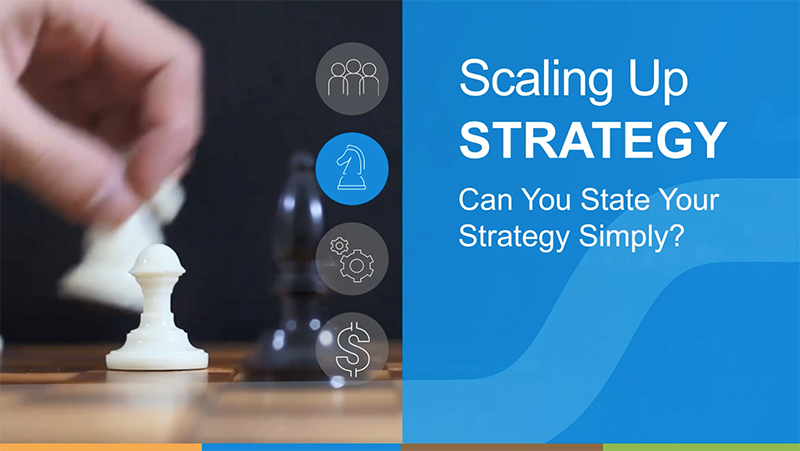
Can you state your strategy simply? One of our most important tools to create a clear, simple strategy during these times of crisis is the SWT section of the One-Page Strategic Plan.
SWT stands for strengths, weaknesses, and trends. This is different from the conventional SWOT analysis (strengths, weaknesses, opportunities, threats). The key is to determine how you can match your strengths to leverage a trend and pivot or rebuild.
When you have identified the trends, the first thing you need to do is sit down with your team and ask yourselves, “Where is the puck going?” Then, you've got to face the brutal facts. What are your core competencies, core strengths, and core capabilities?
For example, a company that makes cheap pens is not just a pen manufacturer. Their core competency is making disposable, plastic consumables. With disposable gloves now being the fastest growing trend in commerce, such a company could make a pivot to produce single-use gloves.
Case Study: Timberlane’s Complete Pivot
During a Health Crisis
Rick Skidmore, an early student of mine, has a company called Timberlane that traditionally makes custom exterior shutters and shutter hardware. It’s a niche business that has done really well, providing exterior shutters to various sites including the White House and Disneyland.
When this crisis hit, his revenue dropped 75% overnight. He immediately pulled back 90% of his marketing and was about to furlough 60 of his employees when he decided to instead analyze what the company’s key competencies were. 
Identifying manufacturing as their core competency, Rick pivoted his business to manufacture medical safety supplies to respond to the COVID-19 crisis.
Leveraging his relationships, he was able to reach into the hospital networks and government agencies. 11 days later, not only were his 60 employees still fully employed, they now have 167 new temp employees being processed. Timberland has added 65 additional workstations so far, which will likely swell to 200 within a week. They've also launched a donation page to allow people to buy and donate PPEs to the local community first responders.
Once you've narrowed in on what the new opportunity you can leverage to rebuild or pivot your company. You can use the 7 Strata tool to create a new category you can dominate.
Key #3: Scaling Up Execution
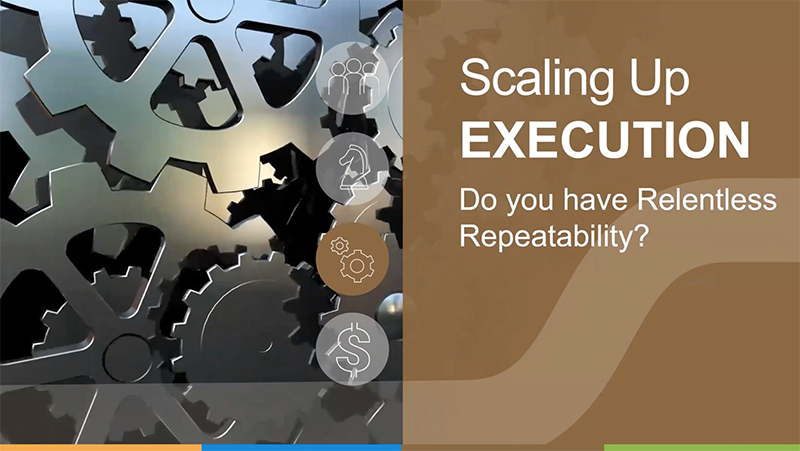
You’ve identified an opportunity to pivot or rebuild. You’ve reached out to your customer base and other important business relationships. You’ve decided on a strategy to focus on. What’s next?
The answer is execution. Do you have relentless repeatability? One piece of advice I always stress upon when it comes to execution is, “The main thing is to keep the main thing, the main thing.”
What this all boils down to is the “Theory of Constraints”. The Theory of Constraints is a methodology for identifying the biggest constraint preventing you from achieving a goal, then systematically improving that constraint until it is no longer a bottleneck for you. This is exactly what Rick from Timberlane has been doing to execute the pivot of his company.
His very first constraint was getting the raw materials in fast enough. Everyone was fighting for the limited supply of raw materials. Rick focused on finding a solution for this constraint and eventually found a source through LinkedIn to secure the raw materials he needed.
(A little side note: We’re finding LinkedIn to be an outstanding place where you can ask for help and gather the kind of resources needed for you to move forward.)
If you’re not spending your time to solve your most immediate constraint, then you’re really wasting time.
During this crisis, it’s critical for you to move fast. It’s imperative for you to focus on eliminating your constraints as fast as you can.
Key #4: Scaling Up Cash
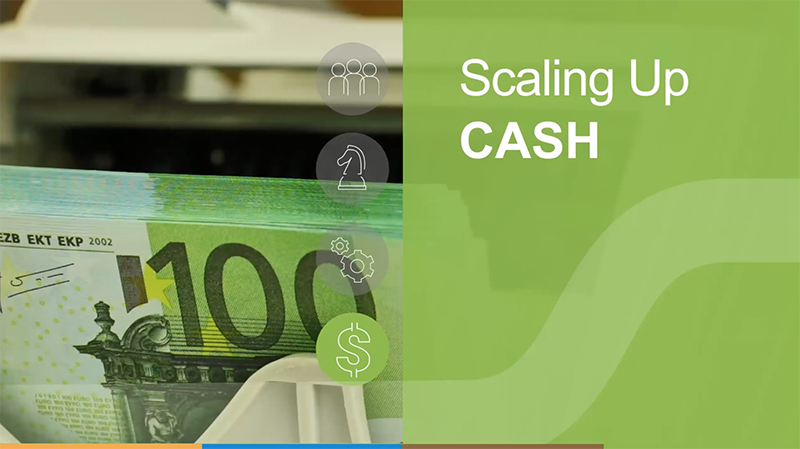
I remember when 9/11 happened, we were scheduled to host our very first summit eight weeks later. It was in partnership with Fortune Magazine, and we needed that to look good. We had just started the company about 36 months before — then boom — overnight people did not want to get on airplanes. We were out of business. I had lost $1 million in about 10 weeks.
That's when I sat down and made a list of all the customers we had a great relationship with. I called every one of them and 17 of them got back to me saying that they were coming out of the 9/11 crisis well. With projections to continue doing well in 2002, they expressed interest to work with us as they continued to scale. So I offered them a 25% discount if they would prepay for the services in advance, and all 17 of them agreed. That gave me the cash injection I needed to relaunch.
The key point here is you’ll need to start thinking out of the box on how you can get cash flow from alternative sources.
Case Study: Flow Hive Built Influencer Relationships Over 6 Months To Launch
Stuart and Cedar Anderson are a father-son team from Australia who created a beehive design system that makes it easy to extract honey by simply turning a lever.
They called the system, “Flow Hive”, and it could be 3D printed, which meant they didn’t need to hold inventory.
With this idea, they needed $70,000 for a custom injection mold so they could launch the business.
To get the capital, they turned to potential customers. In February 2015, they launched a campaign on the crowdfunding platform Indiegogo.
The son, Cedar, made a list of who he thought would be the top 25 bloggers, influencers, and writers that could help them reach the 3 million niche market of people who grow their own food and produce.
He began to nurture those relationships over 60 days saying and the results were astounding.
They pre-sold a quarter-million of this $600 device in the first 15 minutes of launching the campaign. Then, they hit the first million in revenue in three hours. They further doubled it within the next 11 hours.
By the time the dust settled 30 days later, they raised over $12 million and received nearly 25,000 orders from over 130 countries.
In early 2018, they launched another crowdfunding campaign for the launch of Flow Hive 2 and raised over $14.9 million in pre-sales. They are now an award-winning thriving family business.
Summary
I want to end this article by sharing with you a different perspective on the current crisis we face.
At the beginning of the century, our global economy was $34 trillion. Last year, it was 88 trillion. That’s a two and a half increase in just 20 years. People are predicting that the global economy could drop by 8-25%.
Even in the worst-case scenario where the global economy drops by 25%, that still means the global economy is over twice what it was at the beginning of the century. Somebody is going to get their piece of that 65 to 70 trillion if not more. Why not you? Surviving an economic downturn is possible — but you must first firmly believe that.
So let me wrap up really four things. First, I want you to sit down and make the list. Number two, I want you to figure out what is going to be your strategy moving forward, really understanding your capabilities and the trends. Then, what is the word or two that you're going to own? Number three, you have to focus your effort. Each step of the way you need to see what is the next rock on your way up the mountain and eliminate the constraints. Finally, the truth is, this is when we have to go back and rely on your customers to fund the business.
Remember to have a bias for action. We have to plan for the worst but hope for the best. And if you implement the four keys I’ve shared with you here, you’re giving yourself the best shot at securing the best.
Join Scaling Up Master Business Course
If you’re looking for extra support to implement your winning strategy to help you thrive into 2020, then now is the best time to join our revamped Scaling Up Master Business Course.
Based on the key pillars of Scaling Up, this program is designed to help your organization adopt a new strategy quickly and efficiently. All the Scaling Up tools can be studied and implemented virtually – and we’re providing extra assistance by bringing in guest speakers, more live sessions, and an even stronger community support system than before.
Now is not the time to be alone. Surviving the crisis requires us to learn and stick together. Learn more about how we will help you practically scale your business with the Scaling Up Master Business Course so you can learn how to manage chaos and get aligned to thrive this year!




